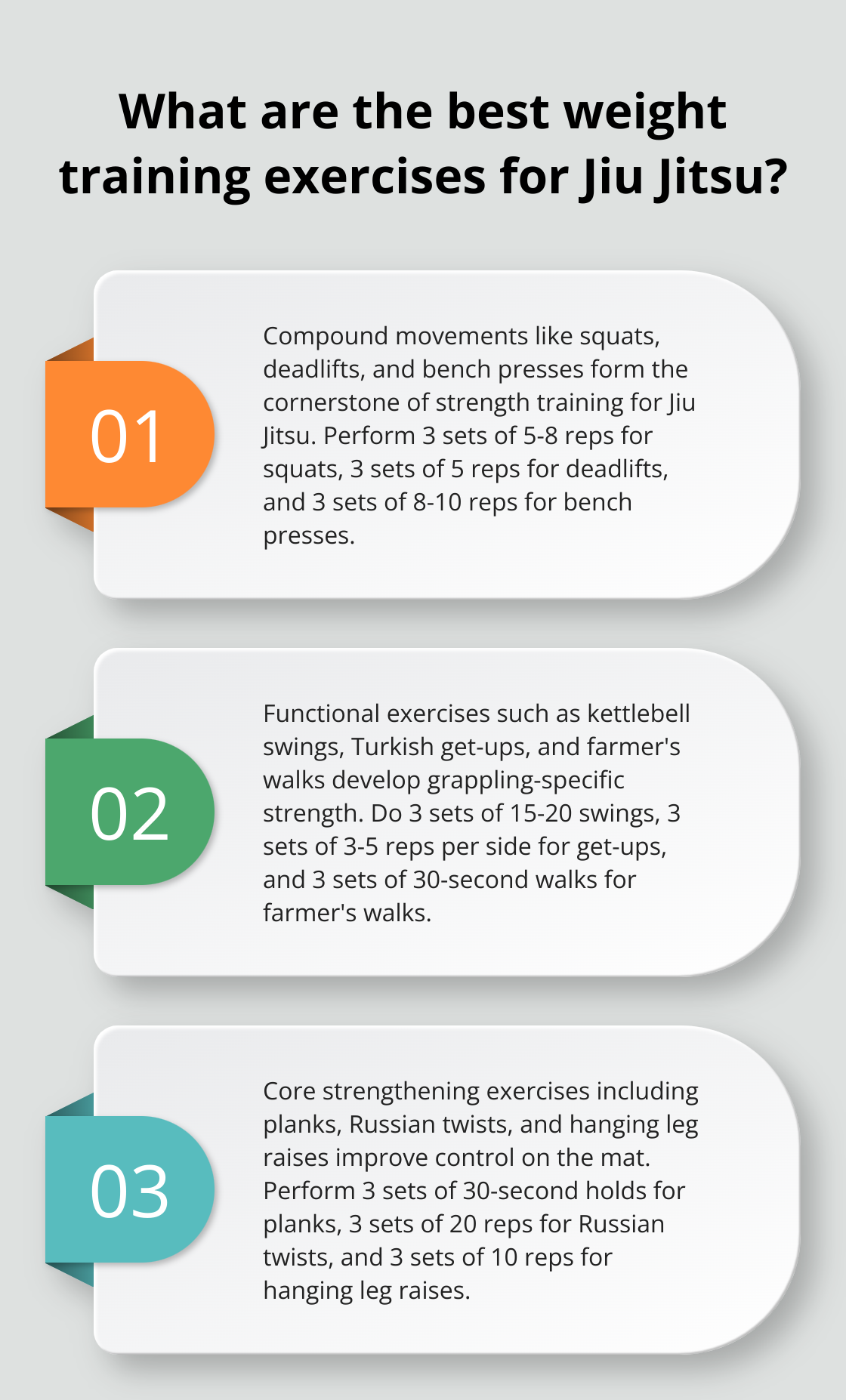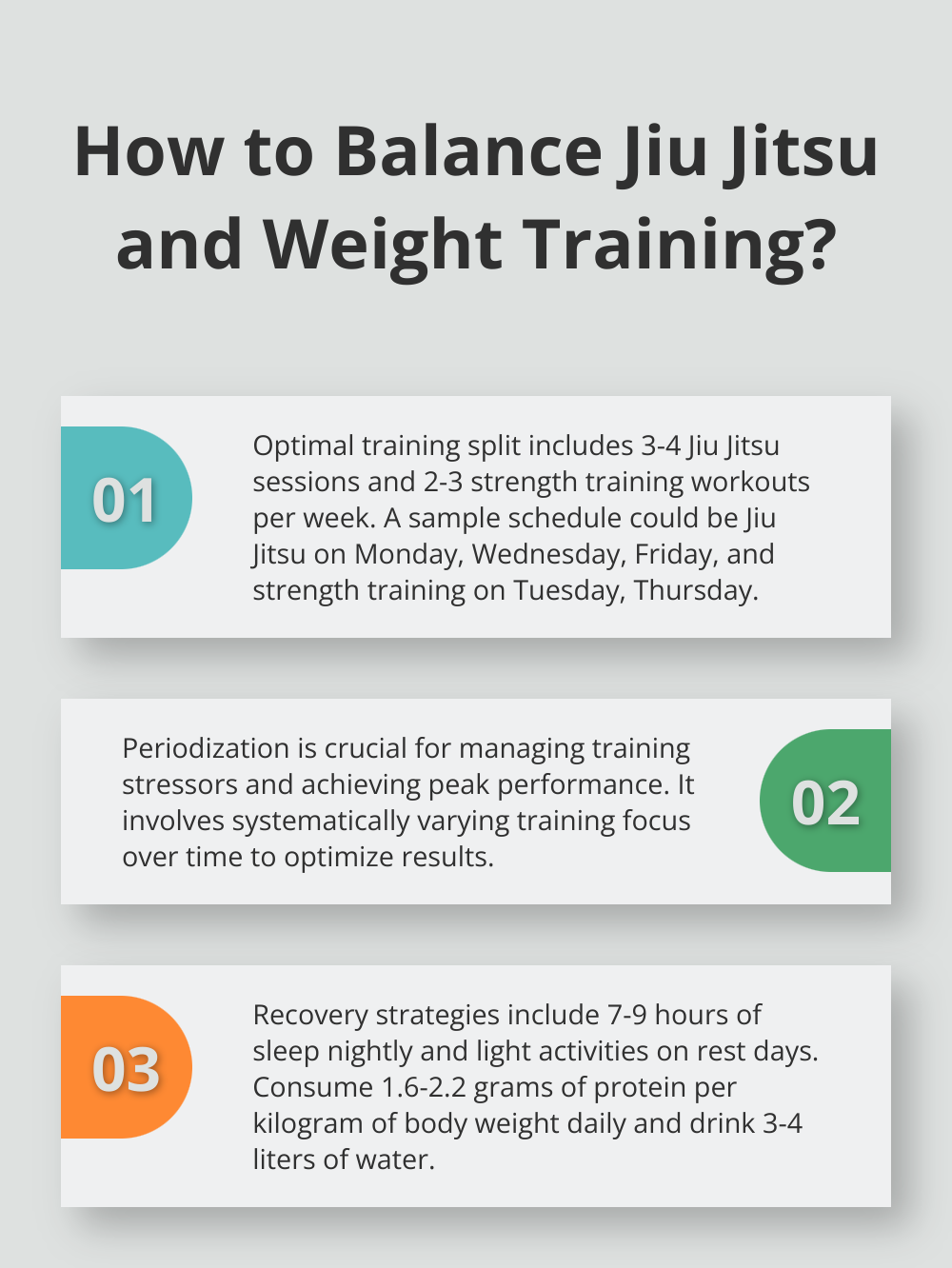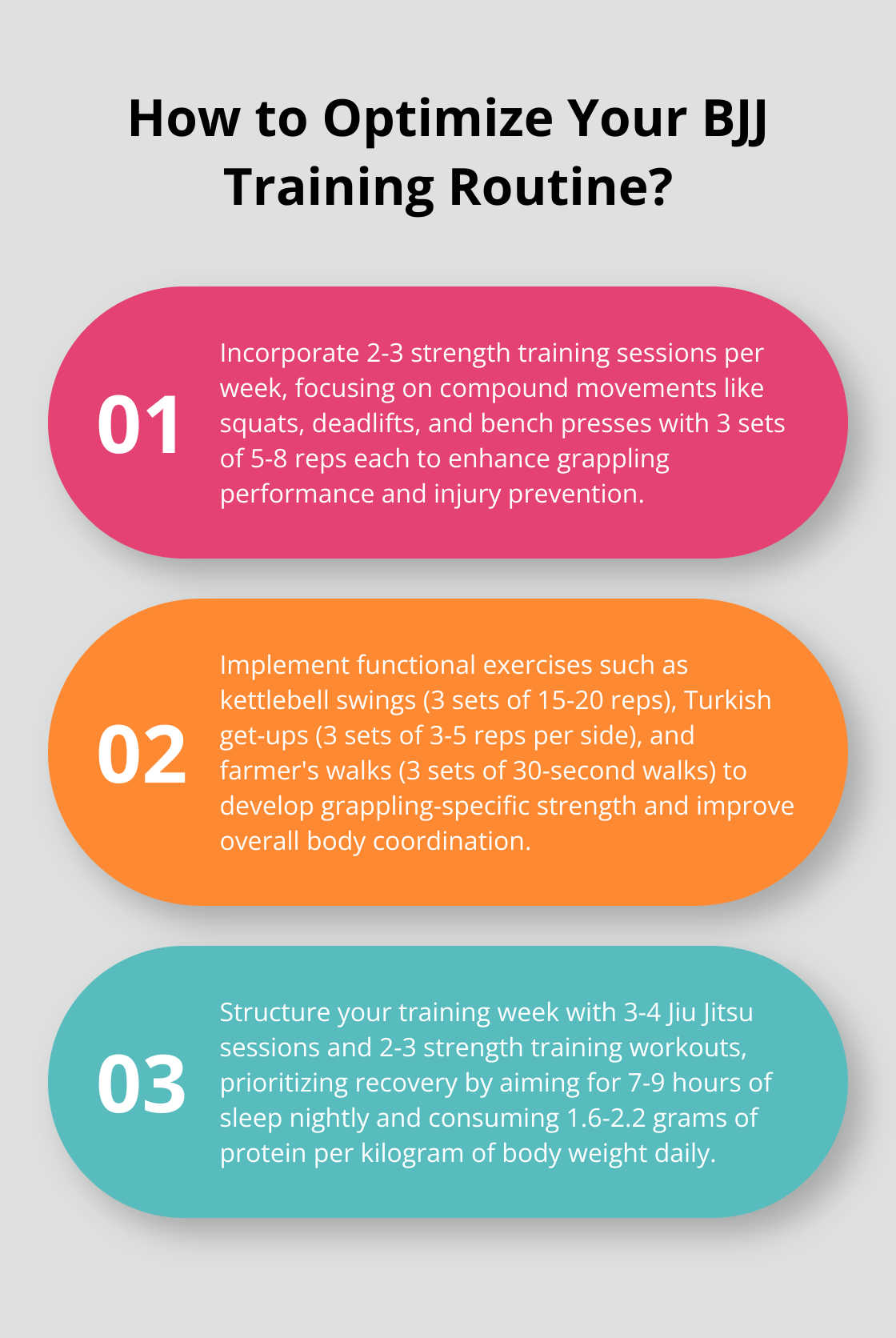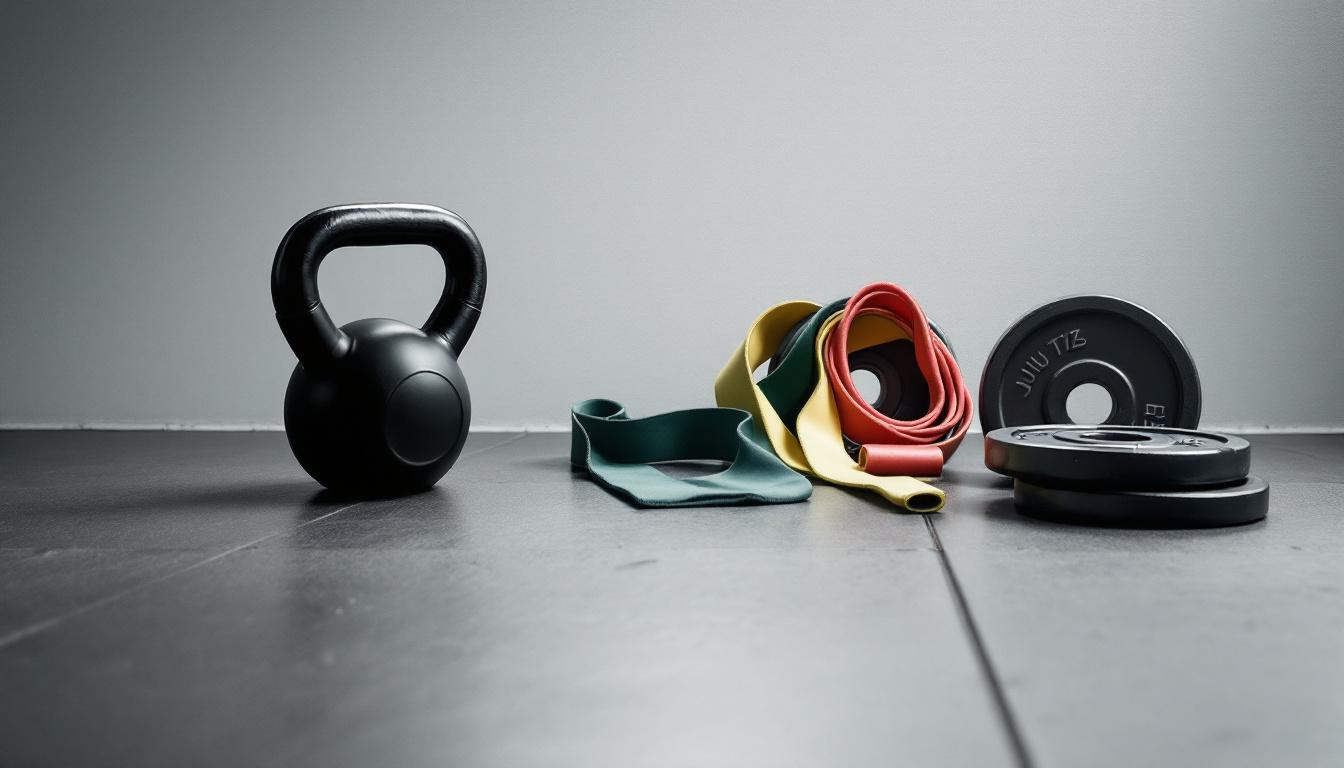At Jiu Jitsu, we know that strength is a game-changer on the mat.
A well-designed Jiu Jitsu weight training program can significantly boost your performance, giving you an edge over your opponents.
In this post, we’ll explore how to effectively incorporate strength training into your Jiu Jitsu routine, maximizing your potential and minimizing injury risks.
Why Weight Training Matters in Jiu Jitsu
Dominate Your Opponents
Weight training transforms Jiu Jitsu performance. It’s not just about muscle; it’s about enhancing your mat game. Strength training directly translates to better grappling performance. Stronger practitioners execute techniques more effectively and maintain control over opponents. Maximal dynamic, isometric and endurance strength can be associated with sporting success in Brazilian jiu-jitsu athletes.
Outlast the Competition
Endurance plays a vital role in Jiu Jitsu, especially during longer matches. Weight training improves muscular endurance, allowing high-level performance for extended periods. This boost enables them to push harder for longer during matches.
Stay in the Game
Injury prevention stands as one of the most underrated benefits of weight training for Jiu Jitsu. Strengthening muscles, tendons, and ligaments makes the body more resilient to grappling stresses.
Integrate Strength Training Effectively
To maximize benefits, try 2-3 strength training sessions per week (focusing on compound movements that mimic Jiu Jitsu techniques). As you progress, you’ll notice improvements not just in strength, but in your overall Jiu Jitsu game.

Souza Grappling Co.’s 3,000 sq. ft. facility is equipped to help integrate strength training into Jiu Jitsu practice effectively. Our expert trainers can guide you in developing a strength training program that complements your Jiu Jitsu goals, whether you’re a beginner or an advanced practitioner.
Now that we understand the importance of weight training, let’s explore specific exercises that can take your Jiu Jitsu performance to new heights.
Powerful Exercises for Jiu Jitsu Success
At Souza Grappling Co., we’ve witnessed how the right exercises transform a practitioner’s performance on the mat. Let’s explore some of the most effective weight training exercises that will elevate your Jiu Jitsu game.
Compound Movements for Total Body Strength
Squats, deadlifts, and bench presses form the cornerstone of any solid strength training program for Jiu Jitsu. These exercises engage multiple muscle groups simultaneously, mimicking the full-body demands of grappling.

Squats strengthen your legs and core, which are essential for maintaining a strong base and executing powerful takedowns. Try 3 sets of 5-8 reps, focusing on proper form to maximize benefits and minimize injury risk.
Deadlifts target your posterior chain, enhancing your ability to bridge and shrimp effectively. Start with 3 sets of 5 reps, gradually increasing weight as your form improves.
Bench presses build upper body strength, vital for controlling opponents and applying submissions. Incorporate 3 sets of 8-10 reps into your routine, balancing pushing movements with pulling exercises like rows for overall shoulder health.
Functional Exercises for Grappling-Specific Strength
Kettlebell swings, Turkish get-ups, and farmer’s walks excel at developing functional strength that directly translates to the mat.
Kettlebell swings improve explosive hip power (essential for executing sweeps and throws). Perform 3 sets of 15-20 swings, focusing on hip drive rather than arm strength.
Turkish get-ups enhance total body coordination and stability, mirroring the complex movements in Jiu Jitsu. Start with 3 sets of 3-5 reps per side, using a light weight until you master the technique.
Farmer’s walks build grip strength and overall body tension (key for maintaining control in grappling situations). Try 3 sets of 30-second walks, gradually increasing weight and distance.
Core Strengthening for Improved Control
A strong core provides stability and power in every technique. Planks, Russian twists, and hanging leg raises effectively develop core strength.
Planks build isometric strength, improving your ability to maintain positions. Start with 3 sets of 30-second holds, progressing to longer durations or more challenging variations.
Russian twists target rotational strength, vital for executing and defending against submissions. Perform 3 sets of 20 reps, using a medicine ball or weight plate for added resistance.
Hanging leg raises strengthen the lower abs and hip flexors, enhancing guard retention and leg lock defense. Begin with 3 sets of 10 reps, focusing on controlled movement throughout the exercise.
Consistency proves key in reaping the benefits of these exercises. Incorporate them into your routine 2-3 times per week, always prioritizing proper form over heavy weights. As your strength, endurance, and overall Jiu Jitsu performance improve, you’ll need to adapt your training regimen to continue challenging yourself. Let’s explore how to effectively integrate weight training into your Jiu Jitsu routine in the next section.
Mastering the Balance: Jiu Jitsu and Weight Training
At Souza Grappling Co., we have fine-tuned the art of integrating weight training into Jiu Jitsu routines. The key lies in strategic planning and smart execution. Here’s how to seamlessly blend these two disciplines for maximum impact.
Optimal Training Split
A well-structured training week typically includes 3-4 Jiu Jitsu sessions and 2-3 strength training workouts. This balance ensures adequate mat time while allowing for strength gains. For instance, you might practice Jiu Jitsu on Monday, Wednesday, and Friday, with strength training on Tuesday and Thursday. Saturday could be a flex day for either discipline, while Sunday remains a rest day.
Periodization for Peak Performance
Periodization involves systematically varying training focus over time. A periodized training plan is needed to manage the integration of this sport’s many training stressors. This approach provides guidelines and practical examples for athletes and coaches.
Recovery and Nutrition: The Unsung Heroes
Effective recovery is essential when combining Jiu Jitsu and weight training. Implement these strategies:
- Sleep: Try to get 7-9 hours nightly. Quality sleep enhances muscle recovery and cognitive function.
- Active recovery: Light activities (like yoga or swimming) on rest days promote blood flow and reduce soreness.
- Nutrition: Consume 1.6-2.2 grams of protein per kilogram of body weight daily to support muscle recovery and growth. Carbohydrates should comprise 45-65% of total calorie intake for energy during training.
- Hydration: Drink at least 3-4 liters of water daily, adjusting based on activity level and climate.

Progress happens during recovery, not just during training. Prioritize these elements to maximize your Jiu Jitsu and strength training efforts.
Tailoring Your Program
Every athlete is unique, so it’s important to tailor your training program to your specific needs and goals. Consider factors such as:
- Your current fitness level
- Your Jiu Jitsu experience
- Your competition schedule (if applicable)
- Any injuries or limitations you may have
Adjust your training split, exercise selection, and intensity based on these factors. Regular reassessment (every 4-6 weeks) will help you stay on track and make necessary adjustments.
Final Thoughts
Weight training transforms Jiu Jitsu performance. A well-designed Jiu Jitsu weight training program improves strength, power, endurance, and injury resistance. These enhancements allow practitioners to execute techniques more effectively and maintain control over opponents.

Consistency proves essential to reap the rewards of strength training. Practitioners should increase workout intensity and complexity as they progress (always prioritizing proper form over heavy weights). Our expert trainers at Souza Grappling Co. can develop a personalized program that complements your Jiu Jitsu practice.
Take the first step towards elevating your Jiu Jitsu game today. Souza Grappling Co. offers a 3,000 sq. ft. facility equipped to integrate strength training into your routine effectively. Your journey to become a stronger, more resilient, and more formidable Jiu Jitsu practitioner starts now.




